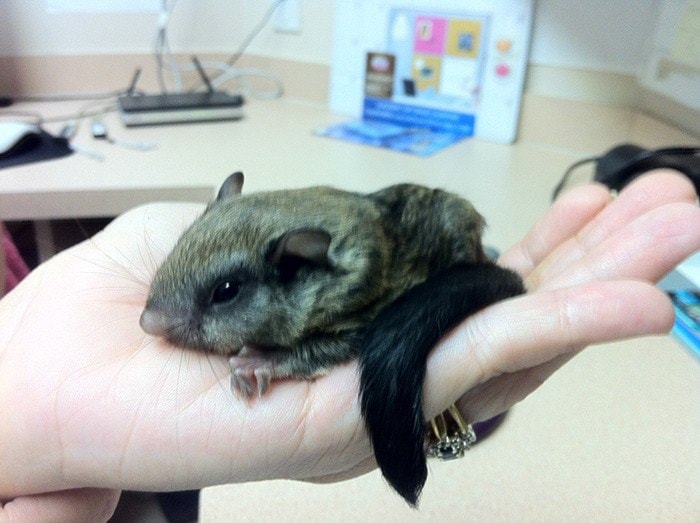Poor little Norman likely didn’t know what hit him when he landed in the middle of the road, off of 240th Street in Maple Ridge.
Lucky for Norman, a northern flying squirrel, Sue Cummings happened to be walking by at the time, and waded into traffic to save him.
“There were big trucks zooming right by him,” said Cummings, who is the office manager at Dewdney Animal Hospital.
“The little Smurf didn’t know where he was.”
Cummings believes Norman likely fell out of one of the trees that were being cut down on an adjacent property.
With his nest likely destroyed, leaving Norman without a cache of seeds and lichen to get him through the winter, Cummings decided to bring him into the Dewdney Animal Hospital to get rehabbed.
At first glance, vet Dr. Adrian Walton thought he might be looking at a sugar glider, a flying marsupial indigenous to Australia, and sometimes kept as an exotic pet.
“No one ever sees [flying squirrels] because they’re nocturnal, and they never come out of the treetops,” Walton said.
Norman likely had some minor internal injuries from the fall out of his tree, Walton determined. After hand-feeding him this past weekend, his energy is back and he his exploring the cage Walton has put him in, instead of cowering in a corner.
“He’s perked right up now,” said Walton.
While the local vet office is licensed by the provincial government as a wild animal rehab facility, it by no means ideal for Norman.
“The best thing for him would to be around other flying squirrels, or at the very least, in a facility that specializes in flying squirrels or has some experience with them,” he said.
Given that Norman is still a juvenile, he will likely have to be rehabbed over the winter and released this spring.
If a suitable rehab facility can’t be found, Walton said they will build a more permanent home for Norman to house him over the winter.
“He’s not quite ready to be on his own yet,” said Walton.
Northern flying squirrel:
• the squirrels can glide anywhere from five to 25 metres;
• adult northern flying squirrels measure more than 30 cm long, and can weigh up to 230 grams;
• northern flying squirrels tend to eat seeds, lichen, fungi, nuts, birds eggs, and nuts;
• the flying squirrel doesn’t actually fly, but can glide for up to 25 metres thanks to two furry membranes, called patagia, loosely stretched between its wrists and ankles - it’s flat, furry tail is used as a rudder while gliding;
• northern flying squirrels are among the main prey for the threatened spotted owl;
• range covers every single Canadian province and territory.
Source: Canadian Geographic
